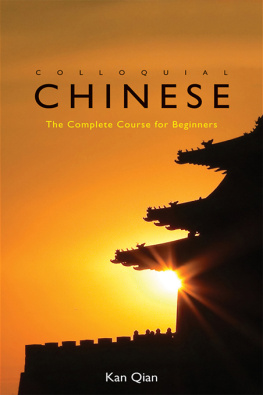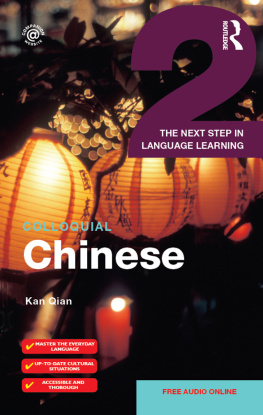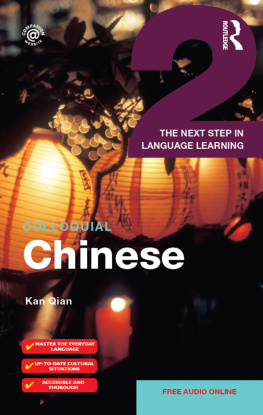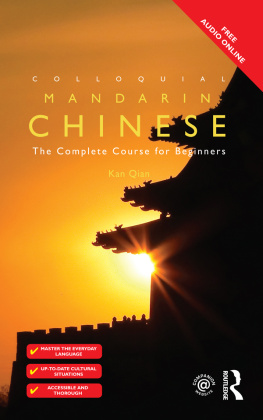 ColloquialChineseMandarinTHE COLLOQUIAL SERIESSeries Adviser: Gary King The following languages are available in the Colloquial series:
ColloquialChineseMandarinTHE COLLOQUIAL SERIESSeries Adviser: Gary King The following languages are available in the Colloquial series:
| Afrikaans | French | Portuguese |
| Albanian | German | Portuguese of Brazil |
| Amharic | Greek | Romanian |
| Arabic (Levantine) | Gujarati | Russian |
| Arabic of Egypt | Hausa (forthcoming) | Scottish Gaelic |
| Arabic of the Gulf and Saudi Arabia | Hebrew | Serbian |
| Hindi | Slovak |
| Basque | Hungarian | Slovene |
| Bengali | Icelandic | Somali |
| Breton | Indonesian | Spanish |
| Bulgarian | Irish | Spanish of Latin America |
| Cambodian | Italian | Swahili |
| Cantonese | Japanese | Swedish |
| Catalan | Korean | Tamil |
| Chinese | Latvian | Thai |
| Croatian | Lithuanian | Turkish |
| Czech | Malay | Ukrainian |
| Danish | Mongolian | Urdu |
| Dutch | Norwegian | Vietnamese |
| English | Panjabi | Welsh |
| Estonian | Persian | Yoruba |
| Finnish | Polish | Zulu (forthcoming) |
COLLOQUIAL 2s series: The Next Step in Language Learning| Chinese | German (forthcoming) | Russian |
| Dutch | Italian | Spanish |
| French | Portuguese of Brazil | Spanish of Latin America |
All these Colloquials are available in book & CD packs, or separately. You can order them through your bookseller or via our website www.routledge.com.
ColloquialChineseMandarin The Complete Course for Beginners Kan Qian

First published 1996 by Routledge Reprinted 1997, 1998, 2002, 2003 (twice), 2004, 2005, 2006 Revised edition 1999 This edition published 2009 by Routledge 2 Park Square, Milton Park, Abingdon, Oxon OX14 4RN Simultaneously published in the USA and Canada by Routledge 270 Madison Ave, New York, NY 10016
Routledge is an imprint of the Taylor & Francis Group, an informa business This edition published in the Taylor & Francis e-Library, 2009. To purchase your own copy of this or any of Taylor & Francis or Routledges collection of thousands of eBooks please go to www.eBookstore.tandf.co.uk. 1996, 2009 Kan Qian All rights reserved.
British Library Cataloguing in Publication Data A catalogue record for this book is available from the British Library
Library of Congress Cataloging-in-Publication Data Kan, Qian, 1960 Colloquial Chinese: the complete course for beginners / Qian Kan. 2nd ed. p. cm. (The colloquial series) 1. (The colloquial series) 1.
Chinese language Conversation and phrase books English. 2. Chinese language Grammar. 3. Chinese language Spoken Chinese. Title. Title.
PL1125.E6K36 2009 495.183421 dc22 2008030171 ISBN 0-203-88362-4 Master e-book ISBN ISBN13: 978-0-415-43415-7 (pbk) ISBN13: 978-0-415-43416-4 (audio CDs) ISBN13: 978-0-415-43417-1 (pack) ISBN13: 978-0-415-55159-5 (MP3)  Acknowledgements I am indebted to Dr Andrew Brown, who helped me throughout the writing of the first edition of this book. Not only did he spend many hours polishing my English, but he also put himself in the position of a learner for this book. The criticism and comments he made were extremely helpful in enabling me to search for the most appropriate way of expressing many language points. Over the last ten years or so, many teachers and learners who used the first and/or the revised edition of this book wrote to me with their extremely useful feedback, to whom I am very grateful. I would particularly like to thank Dr Yip Poching, Chen Guangqin, Wang Xiaoning, Yu Feixia and Guo Zhiyan for taking the time to provide very specific and good suggestions. My special thanks go to Kan Jia for countless hours of word processing, pinyin annotation and proof-reading the Chinese texts.
Acknowledgements I am indebted to Dr Andrew Brown, who helped me throughout the writing of the first edition of this book. Not only did he spend many hours polishing my English, but he also put himself in the position of a learner for this book. The criticism and comments he made were extremely helpful in enabling me to search for the most appropriate way of expressing many language points. Over the last ten years or so, many teachers and learners who used the first and/or the revised edition of this book wrote to me with their extremely useful feedback, to whom I am very grateful. I would particularly like to thank Dr Yip Poching, Chen Guangqin, Wang Xiaoning, Yu Feixia and Guo Zhiyan for taking the time to provide very specific and good suggestions. My special thanks go to Kan Jia for countless hours of word processing, pinyin annotation and proof-reading the Chinese texts.
Finally, I wish to thank the editors and the assistant staff concerned at Routledge for their patience and support throughout the writing of this edition. Introduction The Chinese language Some people in the west believe the Chinese language to be Cantonese whereas in fact Cantonese is just one of the eight major dialects of the Chinese language. Although different dialects differ immensely in pronunciation, they share the same written form. The Northern dialect (which has many sub-dialects under it) is spoken by 70 per cent of the Chinese population. Therefore, the standard language spoken nationally is based on the pronunciation of the Northern dialect. The name for this standard form is Putonghua (common speech) in mainland China, Guoyu or Huayu (national language) in Taiwan, Hong Kong, and other overseas Chinese communities, and Mandarin Chinese in English-speaking countries.
Other forms such as Zhongwen (Chinese) or Hanyu (the Han language, Han Chinese making up 93 per cent of the Chinese population) are more formal and are often used among Chinese language learners. Native Chinese speakers often use the term Zhongwen rather than Putonghua when they ask non-native Chinese speakers if they speak Chinese. Putonghua is taught in schools and spoken by television and radio presenters in mainland China, and it is the kind of spoken language which is most understood by Chinese speakers. This book deals with Putonghua. Romanization Various systems have been devised for transcribing Chinese sounds into the Latin script. Pinyin uses 26 letters in total, 25 of which are English letters. Pinyin uses 26 letters in total, 25 of which are English letters.
The exception is the letter v, which is replaced by the following symbol: . Pinyin was adopted as the official system in the Peoples Republic of China in 1958, and has since become a standard form used by news agencies as well as educational institutions. Pinyin has now been adopted almost universally in the west for transliterating Chinese personal names and place names although in older books you may still find earlier romanization systems in use (e.g. Beijing is the pinyin transliteration and Peking is the WadeGiles transliteration). In mainland China, pinyin is used as a tool to teach the correct pronunciation of Putonghua to children starting school. In dictionaries pinyin is given next to the character to indicate the pronunciation.
Many street signs in big cities in mainland China have pinyin directly underneath the Chinese characters. The speech sounds Chinese is a vowel-dominated language. A syllable may consist of a single vowel, a compound vowel or a vowel preceded by a consonant. A compound vowel may consist of two vowels or a vowel with a nasal sound, which is treated as one unit. This is probably why consonants are called initials (shengmu) and vowels are called finals (yunmu) in Chinese.  1 Initials (CD1; 2) There are twenty-three initials (some people regard w and y as semi-vowels) in modern Chinese.
1 Initials (CD1; 2) There are twenty-three initials (some people regard w and y as semi-vowels) in modern Chinese.
Next page







![Yi Ren - Mandarin Chinese for Beginners: Learning Conversational Chinese / Mastering Conversational Chinese [Book]](/uploads/posts/book/146887/thumbs/yi-ren-mandarin-chinese-for-beginners-learning.jpg)




 ColloquialChineseMandarinTHE COLLOQUIAL SERIESSeries Adviser: Gary King The following languages are available in the Colloquial series:
ColloquialChineseMandarinTHE COLLOQUIAL SERIESSeries Adviser: Gary King The following languages are available in the Colloquial series: First published 1996 by Routledge Reprinted 1997, 1998, 2002, 2003 (twice), 2004, 2005, 2006 Revised edition 1999 This edition published 2009 by Routledge 2 Park Square, Milton Park, Abingdon, Oxon OX14 4RN Simultaneously published in the USA and Canada by Routledge 270 Madison Ave, New York, NY 10016 Routledge is an imprint of the Taylor & Francis Group, an informa business This edition published in the Taylor & Francis e-Library, 2009. To purchase your own copy of this or any of Taylor & Francis or Routledges collection of thousands of eBooks please go to www.eBookstore.tandf.co.uk. 1996, 2009 Kan Qian All rights reserved. British Library Cataloguing in Publication Data A catalogue record for this book is available from the British Library Library of Congress Cataloging-in-Publication Data Kan, Qian, 1960 Colloquial Chinese: the complete course for beginners / Qian Kan. 2nd ed. p. cm. (The colloquial series) 1. (The colloquial series) 1.
First published 1996 by Routledge Reprinted 1997, 1998, 2002, 2003 (twice), 2004, 2005, 2006 Revised edition 1999 This edition published 2009 by Routledge 2 Park Square, Milton Park, Abingdon, Oxon OX14 4RN Simultaneously published in the USA and Canada by Routledge 270 Madison Ave, New York, NY 10016 Routledge is an imprint of the Taylor & Francis Group, an informa business This edition published in the Taylor & Francis e-Library, 2009. To purchase your own copy of this or any of Taylor & Francis or Routledges collection of thousands of eBooks please go to www.eBookstore.tandf.co.uk. 1996, 2009 Kan Qian All rights reserved. British Library Cataloguing in Publication Data A catalogue record for this book is available from the British Library Library of Congress Cataloging-in-Publication Data Kan, Qian, 1960 Colloquial Chinese: the complete course for beginners / Qian Kan. 2nd ed. p. cm. (The colloquial series) 1. (The colloquial series) 1.  Acknowledgements I am indebted to Dr Andrew Brown, who helped me throughout the writing of the first edition of this book. Not only did he spend many hours polishing my English, but he also put himself in the position of a learner for this book. The criticism and comments he made were extremely helpful in enabling me to search for the most appropriate way of expressing many language points. Over the last ten years or so, many teachers and learners who used the first and/or the revised edition of this book wrote to me with their extremely useful feedback, to whom I am very grateful. I would particularly like to thank Dr Yip Poching, Chen Guangqin, Wang Xiaoning, Yu Feixia and Guo Zhiyan for taking the time to provide very specific and good suggestions. My special thanks go to Kan Jia for countless hours of word processing, pinyin annotation and proof-reading the Chinese texts.
Acknowledgements I am indebted to Dr Andrew Brown, who helped me throughout the writing of the first edition of this book. Not only did he spend many hours polishing my English, but he also put himself in the position of a learner for this book. The criticism and comments he made were extremely helpful in enabling me to search for the most appropriate way of expressing many language points. Over the last ten years or so, many teachers and learners who used the first and/or the revised edition of this book wrote to me with their extremely useful feedback, to whom I am very grateful. I would particularly like to thank Dr Yip Poching, Chen Guangqin, Wang Xiaoning, Yu Feixia and Guo Zhiyan for taking the time to provide very specific and good suggestions. My special thanks go to Kan Jia for countless hours of word processing, pinyin annotation and proof-reading the Chinese texts. 1 Initials (CD1; 2) There are twenty-three initials (some people regard w and y as semi-vowels) in modern Chinese.
1 Initials (CD1; 2) There are twenty-three initials (some people regard w and y as semi-vowels) in modern Chinese.